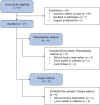Impact of hyperoxia and phenylephrine on cerebral oxygenation: An experimental clinical study
- PMID: 36112064
- PMCID: PMC10092244
- DOI: 10.1111/aas.14149
Impact of hyperoxia and phenylephrine on cerebral oxygenation: An experimental clinical study
Abstract
Background: Oxygen supply to the brain is of special importance during intracranial surgery because it may be compromised by intracranial pathology. A high arterial blood pressure (mean arterial pressure above 80 mmHg) and a high arterial oxygen tension (PaO2 above 12 kPa) is therefore often targeted in these patients, when for example intracranial pressure is increased or when a mass effect on brain tissue from a tumour is present, and it is pursued by administering vasopressors such as phenylephrine and by increasing inspiratory oxygen fraction (FiO2 ). However, whether these interventions increase cerebral oxygenation remains uncertain. We aimed to investigate the effect of hyperoxia and phenylephrine on brain tissue oxygen tension (PbtO2 ) in patients undergoing craniotomy.
Methods: In this experimental study, we included 17 adult patients scheduled for elective craniotomy. After securing a stable baseline of the oxygen probe, PbtO2 was measured in white matter peripherally in the surgical field during general anaesthesia. Primary comparisons were PbtO2 before versus after an increase in FiO2 from 0.30 to 0.80 as well as before versus after a bolus dose of phenylephrine (0.1-0.2 mg depending on patient haemodynamics). Data were analysed with the Wilcoxon signed rank test.
Results: We obtained complete data sets in 11 patients undergoing the FiO2 increase and six patients receiving the phenylephrine bolus. PbtO2 was 22 (median; 5%-95% range, 4.6-54) mmHg during 30% oxygen, 68 (8.4-99) mmHg during 80% oxygen (p = .004 compared to 30% oxygen), 21 (4.5-81) mmHg before phenylephrine, and 19 (4.2-56) mmHg after phenylephrine (p = .56 compared to before phenylephrine).
Conclusion: In patients undergoing craniotomy under general anaesthesia, brain tissue oxygen tension increased with a high inspiratory oxygen fraction but remained unchanged after a bolus dose of phenylephrine.
Keywords: cerebral oxygenation; hyperoxia; neurosurgery; oxygen; phenylephrine.
© 2022 The Authors. Acta Anaesthesiologica Scandinavica published by John Wiley & Sons Ltd on behalf of Acta Anaesthesiologica Scandinavica Foundation.
Conflict of interest statement
Sofie S. Pedersen: Reports indirect research funding from Boehringer Ingelheim outside the submitted work. Christian S. Meyhoff: Co‐founder of a start‐up company, WARD247 ApS, with the aim of pursuing the regulatory and commercial activities of the WARD‐project (wireless assessment of vital signs). WARD247 ApS has finalised terms for licence agreement for any WARD‐project software and patents. One patent has been filed: ‘Wireless Assessment of Respiratory and circulatory Distress (WARD)—Clinical Support System (CSS)—an automated clinical support system to improve patient safety and outcomes’. Christian S. Meyhoff also reports direct and indirect research funding from Merck Sharp & Dohme Corp., Radiometer and Boehringer Ingelheim, as well as lecture fees from Radiometer, all outside the submitted work. Markus Harboe Olsen: Unrestricted grant from Neurescue Aps outside the submitted work. Zara R. Stisen: None to be reported. Anton Lund: None to be reported. Kirsten Møller: None to be reported. Jane Skjøth‐Rasmussen: None to be reported. Finn B. Moltke: None to be reported. Martin Kryspin Sørensen: None to be reported.
Figures




Similar articles
-
Detection of cerebral hypoperfusion with a dynamic hyperoxia test using brain oxygenation pressure monitoring.Crit Care. 2022 Feb 7;26(1):35. doi: 10.1186/s13054-022-03918-0. Crit Care. 2022. PMID: 35130953 Free PMC article.
-
Brain tissue oxygen tension and its response to physiological manipulations: influence of distance from injury site in a swine model of traumatic brain injury.J Neurosurg. 2016 Nov;125(5):1217-1228. doi: 10.3171/2015.7.JNS15809. Epub 2016 Feb 5. J Neurosurg. 2016. PMID: 26848909
-
Lung Injury Is a Predictor of Cerebral Hypoxia and Mortality in Traumatic Brain Injury.Front Neurol. 2020 Aug 7;11:771. doi: 10.3389/fneur.2020.00771. eCollection 2020. Front Neurol. 2020. PMID: 32849225 Free PMC article.
-
Dangers of hyperoxia.Crit Care. 2021 Dec 19;25(1):440. doi: 10.1186/s13054-021-03815-y. Crit Care. 2021. PMID: 34924022 Free PMC article. Review.
-
The Effects of Hyperoxia on Sea-Level Exercise Performance, Training, and Recovery: A Meta-Analysis.Sports Med. 2018 Jan;48(1):153-175. doi: 10.1007/s40279-017-0791-2. Sports Med. 2018. PMID: 28975517 Review.
Cited by
-
In vivo optical assessment of cerebral and skeletal muscle microvascular response to phenylephrine.FASEB Bioadv. 2024 Aug 21;6(9):390-399. doi: 10.1096/fba.2024-00063. eCollection 2024 Sep. FASEB Bioadv. 2024. PMID: 39399479 Free PMC article.
-
The Impact of Inotropes and Vasopressors on Cerebral Oxygenation in Patients with Traumatic Brain Injury and Subarachnoid Hemorrhage: A Narrative Review.Brain Sci. 2024 Jan 24;14(2):117. doi: 10.3390/brainsci14020117. Brain Sci. 2024. PMID: 38391692 Free PMC article. Review.
References
-
- Floyd TF, Clark JM, Gelfand R, et al. Independent cerebral vasoconstrictive effects of hyperoxia and accompanying arterial hypocapnia at 1 ATA. J Appl Physiol. 2003;95:2453‐2461. - PubMed
-
- Anderson KJ, Harten JM, Booth MG, Kinsella J. The cardiovascular effects of inspired oxygen fraction in anaesthetized patients. Eur J Anaesthesiol. 2005;22:420‐425. - PubMed
-
- Villringer A, Planck J, Hock C, Schleinkofer L, Dirnagl U. Near infrared spectroscopy (NIRS): a new tool to study hemodynamic changes during activation of brain function in human adults. Neurosci Lett. 1993;154:101‐104. - PubMed
MeSH terms
Substances
Grants and funding
LinkOut - more resources
Full Text Sources
Medical

